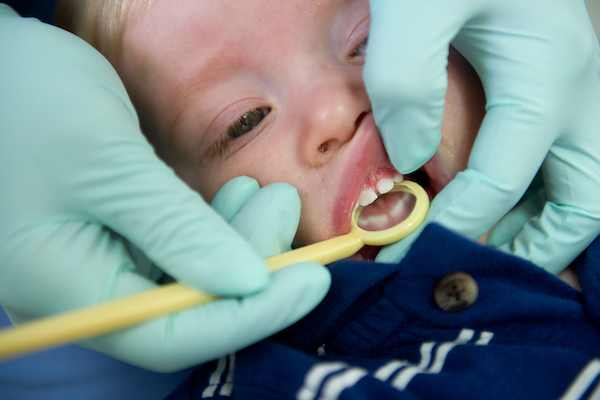 Tooth decay can be prevented or managed if children have early dental visits and if parents or other caregivers take good care of their child’s teeth between dental visits. Head Start staff play a key role in helping parents understand the importance of regular dental visits, beginning with the first dental visit by age 1. Goals of dental visits are preventing tooth decay and finding and treating oral problems early.
Tooth decay can be prevented or managed if children have early dental visits and if parents or other caregivers take good care of their child’s teeth between dental visits. Head Start staff play a key role in helping parents understand the importance of regular dental visits, beginning with the first dental visit by age 1. Goals of dental visits are preventing tooth decay and finding and treating oral problems early.
This Brush Up on Oral Health tip sheet discusses the importance of the age 1 dental visit. It also offers tips to help Head Start staff explain to parents what happens during the dental visit.
Importance of the Dental Visit
Some parents believe that because primary (baby) teeth are going to “fall out anyway” they do not need to take care of them. However, primary teeth are important to a child’s growth and development. The American Academy of Pediatric Dentistry, the American Academy of Pediatrics, and the American Dental Association all recommend that children have their first dental visit by age 1. A state’s Medicaid and Children’s Health Insurance Program (CHIP) dental fees and payment policies must line up with the state’s pediatric dental periodicity schedule. The American Academy of Pediatric Dentistry maintains a webpage with the dental periodicity schedule for each state.
The age 1 dental visit is a foundation for building a lifetime of good oral health. By beginning visits early, children learn that dental visits are usually not associated with pain or fear of the oral health professional. The visit is also an important opportunity to learn if a child is at high risk for developing tooth decay. During the visit, the oral health professional can talk to parents about steps to reduce their child’s risk for decay.
Explaining to Parents What Happens During the Dental Visit
A child’s first dental visit is usually short. The goal is to make the visit as pleasant as possible. Some oral health professionals ask the parent to sit in the dental chair and hold their child in their lap during the visit. Other oral health professionals use the knee-to-knee position to look into the child’s mouth (see the photo above). During the visit, the oral health professional:
- Describes what they will do during the visit and asks the parents if they have any questions. Parents should be encouraged to ask questions about their child’s oral health and their own oral health.
- Checks the child’s mouth and teeth. Using a small mirror, the oral health professional checks the child’s lips, cheeks, gums, and roof of the mouth for any problems and the teeth for signs of tooth decay.
- Checks the child’s bite and their jaw’s growth. The child’s teeth and jaw will be checked to make sure that they are developing in the right way. The oral health professional may also describe what to expect for the child’s oral development during the next few months.
- Provides preventive care. The oral health professional may provide care to prevent tooth decay. This care may include cleaning the child’s teeth with a toothbrush and applying fluoride varnish. Fluoride varnish is a liquid that is painted onto children’s teeth to prevent tooth decay and to repair early stages of tooth decay. This can be done up to four times a year depending on the child’s risk for developing tooth decay.
- Informs parents about healthy oral hygiene habits. Because home care is a vital part of good oral health, parents may be shown how to brush their child’s teeth and how much fluoride toothpaste to use. The oral health professional may also teach parents how and when to start flossing the child’s teeth. Other topics that may be discussed with parents include the timing of the next dental visit and setting goals to promote their child’s oral health. For example, a goal may be brushing their child’s teeth with fluoride toothpaste twice a day instead of once a day.
- Talks about foods, drinks, and habits that can cause oral problems. The oral health professional may ask questions about feeding practices and the use of sippy cups. Answers to these questions help determine if the child is at high or low risk for developing tooth decay. Parents may also be asked about their child’s thumb sucking, use of pacifiers, and other habits that may cause oral problems.
- Offers tips on how to prevent oral injuries. Injuries to the head, face, and mouth are common in young children, especially when they are learning to walk and climb. The oral health professional may offer tips on how to prevent oral injuries and what to do if an injury occurs.
Even if a child is fearful or cannot cooperate during the dental visit, the visit is still helpful. The child may enjoy riding up and down in the dental chair or seeing how dental tools work, such as the air, water, and suction hoses, and mouth mirror. Often, the oral health professional can get a quick look into the child’s mouth to see if there are any problems.
Download a PDF version to print and share.
Read more:
Resource Type: Article
National Centers: Health, Behavioral Health, and Safety
Audience: Teachers and Caregivers
Series: Brush Up on Oral Health (BUOH)
Last Updated: April 26, 2023
